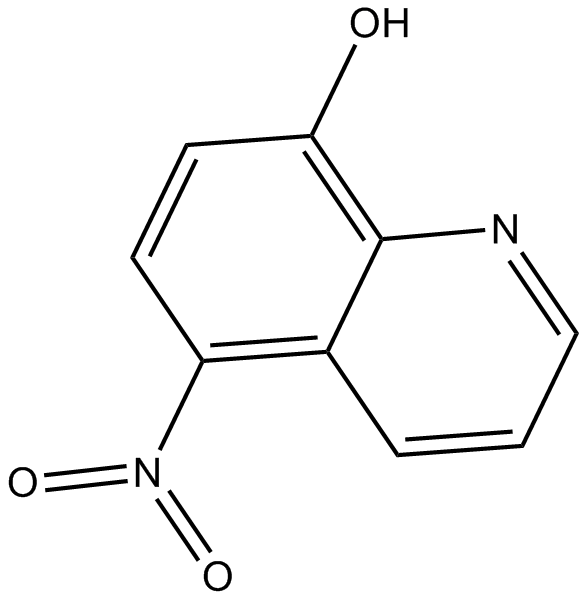Nitroxoline (Synonyms: 8-Hydroxy-5-nitroquinoline, 5-Nitro-8-hydroxyquinoline) |
| Catalog No.GC11365 |
antibacterial agent
Products are for research use only. Not for human use. We do not sell to patients.

Cas No.: 4008-48-4
Sample solution is provided at 25 µL, 10mM.
Nitroxoline has been clinically used since 1962 for the treatment of urinary tract infections, especially those caused by gram negative bacilli. The current renewal of nitroxoline is due to its recently found activity against fungi, U. urealyticum, Mycoplasma, and Trichomonas.
In vitro: The machnistic study showed that nitroxoline, in the treatment of acute or recurrent urinary tract infections caused by Escherichia coli, could be decreased in the presence of Mg2+ and Mn2+ but not Ca2+. Moreover, with the divalent metal ions, a shift in the nitroxoline A448 indicated the formation of drug-ion complexes and a clear correlation was observed between the chelating property and antibacterial activity of nitroxolinet. In addition, it was found that the uptake was energy-independent and with biphasic kinetics: a rapid cell association phase and then a slower increase of cell- nitroxoline association [1].
In vivo: Previous animal study showed that nitroxoline suspension with Tween-80 in a could decrease the tone of the rat and guinea-pig ileum and diminish their peristalsis. Moreover, when administered orally in a dose 50 mg/kg to rats, nitroxoline was able to inhibit the agar-, serotonin-, as well as carrageenin-induced edemas of the rat paws without affecting the response to subplantar histamine injection [2].
Clinical trial: Twelve children were treated with nitroxoline (200 mg/kg/d) during 10 days for urinary tract infection. The results showed eight clinical and bacteriological success, one true failure, and three failure because of a non-compliance to the nitroxoline treatment. In addition, there was no qualitative and quantitative modification of the fecal flora observed after nitroxoline treatment [3].
References:
[1] Pelletier C,Prognon P,Bourlioux P. Roles of divalent cations and pH in mechanism of action of nitroxoline against Escherichia coli strains. Antimicrob Agents Chemother.1995 Mar;39(3):707-13.
[2] Zaks AS,Zil'ber AL,Kapitonenko TA. Spasmolytic and anti-inflammatory activity of 8-hydroxyquinolines. Farmakol Toksikol.1984 Sep-Oct;47(5):44-7.
[3] Lambert-Zechovsky N,Lévêque B,Bingen E,Pillion G,Chapelle J,Mathieu H. Clinical study and effect of nitroxoline on fecal flora in childrenPathol Biol (Paris).1987 May;35(5):669-72.
Average Rating: 5 (Based on Reviews and 2 reference(s) in Google Scholar.)
GLPBIO products are for RESEARCH USE ONLY. Please make sure your review or question is research based.
Required fields are marked with *




















